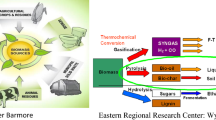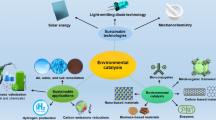Abstract
The dominating route to polychlorinated Dibenzo-p-dioxin and Dibenzofuran formation in the “cold zones” of flue gas cleaning systems of municipal solid waste incinerators is the so-called de novo synthesis, that is, carbonaceous matrix burnoff with simultaneous oxidation and chlorination reactions. Pyrene (1) and Benzodibenzofuran (2) were chosen as the model compounds of carbonaceous material present in fly ash. Possible routes of Dibenzofuran formation by oxidative pathways of compounds (1) and (2) were investigated by theoretical calculations at the density functional theory level. The key intermediate peroxy radical, formed by reaction with molecular oxygen, can follow three main paths leading to Dibenzofuran. In the kinetically favourite path, the highest energetic barriers (25–30 kcal mol−1) are encountered in the steps where CO molecules are released from ketene-like structures. These findings agree with previously reported temperature-programmed desorption results on CO desorption. Moreover, along this path, phenanthrene and biphenyl intermediates are formed, in agreement with the detection of these products in previously reported experimental Pyrene oxidation. Along the preferred path, different steric constraints in compounds (1) and (2) play a role in determining the relative stability of the intermediates, while they have less influence on the energetic barriers. As a consequence, compounds (1) and (2) should present similar kinetic behaviour as they present similar energetic barriers.













Similar content being viewed by others
References
Grandesso E, Ryan S, Gullett B, Touati A, Collina E, Lasagni M, Pitea D (2008) Kinetic modeling of polychlorinated Dibenzo-p-Dioxin and dibenzofuran formation based on carbon degradation reactions. Environ Sci Technol 42:7218–7224
Altarawneh M, Dlugogorski BZ, Kennedy EM, Mackie JC (2009) Mechanisms for formation, chlorination, dechlorination and destruction of polychlorinated Dibenzo-p-Dioxins and dibenzofurans (PCDD/Fs). Prog Energy Combust Sci 35:245–274
Huang H, Buekens A (1996) De novo synthesis of polychlorinated Dibenzo-p-Dioxins and dibenzofurans. Proposal of a mechanistic scheme. Sci Total Environ 193:121–141
Stanmore BR (2004) The formation of dioxins in combustion systems. Combust Flame 136:398–427
Pitea D, Bortolami M, Collina E, Cortili G, Franzoni F, Lasagni M, Piccinelli E (2008) Prevention of PCDD/F formation and minimization of their emission at the stack of a secondary aluminum casting plant. Environ Sci Technol 42:7476–7481
Iino F, Imagawa T, Takeuchi M, Sadakata M (1999) De novo synthesis mechanism of polychlorinated dibenzofurans from polycyclic aromatic hydrocarbons and the characteristic isomers of polychlorinated naphthalenes. Environ Sci Technol 33:1038–1043
Weber R, Iino F, Imagawa T, Takeuchi M, Sakurai T, Sadakata M (2001) Formation of PCDF, PCDD, PCB, and PCN in de novo synthesis from PAH: mechanistic aspects and correlation to fluidized bed incinerators. Chemosphere 44:1429–1438
DeCoster J, Ergut A, Levendis YA, Richter H, Howard JB, Carlson JB (2007) PAH emissions from high-temperature oxidation of vaporized anthracene. Proc Combust Inst 31:491–499
Fullana A, Sidhu SS (2005) Fate of PAHs in the post-combustion zone: partial oxidation of PAHs to dibenzofuran over CuO. J Anal Appl Pyrolysis 74:479–485
Marquaire P, Worner R, Rambaud P, Baronnet F (1999) Organohalogen Compd 40:419–422
Marquaire PM, Bounaceur R, Baronnet F (2003) Detailed mechanism of dibenzofuran oxidation. Organohalogen Compd 63:377–380
Marquaire PM, Wörner R, Baronnet F (2002) Dioxins abatement by total oxidation. IT3’02 conference, May 13–17, New Orleans, Louisiana
Altarawneh M, Dlugogorski BZ, Kennedy EM, Mackie JC (2006) Quantum chemical study of low temperature oxidation mechanism of dibenzofuran. J Phys Chem A 110:13560–13567
Sebbar N, Bockhorn H, Bozzelli JW (2008) Thermochemical similarities among three reaction systems: Vinyl + O2 − Phenyl + O2 − Dibenzofuranyl + O2. Combust Sci Tech 180:959–974
Altarawneh M, Dlugogorski BZ, Kennedy EM, Mackie JC (2007) Theoretical study of reaction pathways of dibenzofuran and Dibenzo-p-Dioxin under reducing conditions. J Phys Chem A 111:7133–7140
Mebel AM, Diau EWG, Lin MC, Morokuma K (1996) Ab initio and RRKM calculations for multichannel rate constants of the C2H3 + O2 reaction. J Am Chem Soc 118:9759–9771
Tokmakov IV, Kim-Sue G, Kislov VV, Mebel AM, Lin MC (2005) The reaction of phenyl radical with molecular oxygen: a G2 M study of the potential energy surface. J Phys Chem A 109:6114–6127
Sebbar N, Bockhorn H, Bozzelli J (2008) Thermodynamic properties of the species resulting from the phenyl radical with O2 reaction system. Int J Chem Kinet 40:583–604
Sebbar N, Bockhorn H, Bozzelli JW (2005) Thermochemical properties, rotation barriers, and group additivity for unsaturated oxygenated hydrocarbons and radicals resulting from reaction of vinyl and phenyl radical systems with O2. J Phys Chem A 109:2233–2253
Sebbar N, Bockhorn H, Bozzelli JW (2004) Thermochemical properties, rotation barriers, bond energies, and group additivity for vinyl, phenyl, ethynyl, and allyl peroxides. J Phys Chem A 108:8353–8366
Ghigo G, Maranzana A, Tonachini G, Zicovich-Wilson CM, Causà M (2004) Modeling soot and its functionalization under atmospheric or combustion conditions by density functional theory within molecular (Polycyclic-Aromatic-Hydrocarbon-like) and periodic methodologies. J Phys Chem B 108:3215–3223
Perry ST, Hambly EM, Fletcher TH, Solum MS, Pugmire RJ (2000) Solid-state 13C NMR characterization of matched tars and chars from rapid coal devolatilization. Proc Combust Inst 28:2313–2319
Homann KH (1998) Fullerenes and soot formation: new pathways to large particles in flames. Angew Chem Int Ed 37:2434–2451
Frisch MJ, Trucks GW, Schlegel HB, Scuseria GE, Robb MA, Cheeseman JR, Scalmani G, Barone V, Mennucci B, Petersson GA, Nakatsuji H, Caricato M, Li X, Hratchian HP, Izmaylov AF, Bloino J, Zheng G, Sonnenberg JL, Hada M, Ehara M, Toyota K, Fukuda R, Hasegawa J, Ishida M, Nakajima T, Honda Y, Kitao O, Nakai H, Vreven T, Montgomery JrJA, Peralta JE, Ogliaro F, Bearpark M, Heyd JJ, Brothers E, Kudin KN, Staroverov VN, Kobayashi R, Normand J, Raghavachari K, Rendell A, Burant JC, Iyengar SS, Tomasi J, Cossi M, Rega N, Millam NJ, Klene M, Knox JE, Cross JB, Bakken V, Adamo C, Jaramillo J, Gomperts R, Stratmann RE, Yazyev O, Austin AJ, Cammi R, Pomelli C, Ochterski JW, Martin RL, Morokuma K, Zakrzewski VG, Voth GA, Salvador P, Dannenberg JJ, Dapprich S, Daniels AD, Farkas Ö, Foresman JB, Ortiz JV, Cioslowski J, Fox DJ (2009) Gaussian 09, Revision A.02. Gaussian Inc. Wallingford CT
Adamo C, Barone V (2002) Physically motivated density functionals with improved accuracy: the modified Perdew-Burke-Ernzerhof model. J Chem Phys 116:5933–5940
Menon AS, Radom L (2008) Consequences of spin contamination in unrestricted calculations on open-shell species: effect of Hartree–Fock and Møller–Plesset contributions in hybrid and double-hybrid density functional theory approaches. J Phys Chem A 112:13225–13230
Mebel AM, Morokuma K, Lin MC (1995) Modification of the Gaussian-2 theoretical model: the use of coupled-cluster energies, density-functional geometries, and frequencies. J Chem Phys 103:7414–7421
Carissan Y, Klopper W (2010) Hydrogen abstraction from biphenyl, acenaphthylene, naphthalene and phenanthrene by atomic hydrogen and methyl radical: DFT and G3(MP2)-RAD data. J Mol Struct THEOCHEM 940:115–118
Marchon B, Tysoe WT, Carrazza J, Heinemann H, Somorjai GA (1988) Reactive and kinetic properties of carbon monoxide and carbon dioxide on a graphite surface. J Phys Chem 92:5744–5749
Acknowledgments
We gratefully acknowledge financial support from the University of Milano-Bicocca (FAR2010). We wish to thank Prof. V. Barone, Scuola Normale di Pisa, Italy, for his constant encouragement and stimulating discussions.
Author information
Authors and Affiliations
Corresponding author
Additional information
Dedicated to Professor Vincenzo Barone and published as part of the special collection of articles celebrating his 60th birthday.
Electronic supplementary material
Below is the link to the electronic supplementary material.
Rights and permissions
About this article
Cite this article
Cosentino, U., Pitea, D. & Moro, G. Computational modelling of de novo synthesis of Dibenzofuran: oxidative pathways of Pyrene and Benzodibenzofuran. Theor Chem Acc 131, 1182 (2012). https://doi.org/10.1007/s00214-012-1182-2
Received:
Accepted:
Published:
DOI: https://doi.org/10.1007/s00214-012-1182-2




